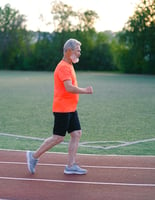I have had a love/hate relationship with pumpkin my whole life. One has to love pumpkin as...
Winning the Bone Density Battle
Osteoporosis is a condition that results from a decrease in bone mineral density (BMD). BMD is an indication of the bone strength in each individual. Studies indicate that our bodies build bone until around age 30. Then we start to reabsorb, or take away old bone tissue faster than we build new bone issue. The bones gradually become more porous, fragile, and prone to break. Many factors affect bone health: decreased estrogen caused by menopause in women, diet, exercise, medications, heredity, aging and cancer treatments.
The relationship between cancer treatments and osteoporosis is well known, Chemo therapies can cause early onset menopause. Hormone replacement therapies can block or decrease estrogen and/or testosterone which can lead to bone loss. Radiation can weaken bones at the treatment site. Corticosteroids, sometimes used to prevent nausea, can negatively affect bone health. In cancer patients, bone loss can occur much quicker than it does with natural aging. Studies have indicated that long term, accelerated bone loss can be up to 80% higher in breast cancer survivors when compared to the aging population. The cancer patient's care team will closely monitor and address bone density if there is concern.
As the keeper of our own health, there are things we can do to maximize good BMD. We are what we eat! Our diet is vital to good bone health.
Calcium consumption and absorption is the key building block for strong bones. Good things to eat include dairy products, turnip greens, broccoli, kale, collards, salmon, sardines, tuna, and tofu.
The successful bone building process includes other nutrients to enable our bodies to use the calcium we eat. Vitamin D needs to be present for calcium to be absorbed from our gut. The sun on our skin is one way we get our vitamin D. It is recommended we get 10 minutes of sun daily between 10 AM and 3 PM on face, arms, or legs. No burning with this brief exposure and it is free! Foods that contain vitamin D include salmon, trout, mackerel, egg yokes, and fortified foods like milk/orange juice/cereals. Other important nutrients that are part of good bone health are magnesium, boron, and potassium. We easily get magnesium in a variety of foods including leafy green vegetables, nuts, salmon, tofu, beans, bananas, whole grains, and fortified foods like breakfast cereals. Boron is found in leafy greens, apples, avocados, almonds, raisins, peaches, beans, and potatoes. Potassium is in avocados, bananas, potatoes, beans, spinach, soy products, tomatoes, oranges, cantaloupe, and yogurt.
There are foods, when consumed in excess, that are not good for strong bones. The large amount of iron that comes in a high protein diet can prevent the body from absorbing the calcium eaten. High salt diets, high alcohol consumption, drinking 4 or more cups of coffee a day, and smoking are all bad for the bones.
Heredity can affect how our bodies absorb calcium. The American Academy of Orthopedic Surgeons has stated that having a family history of osteoporosis puts one at greater risk to develop this condition. This seems to be especially true if there is a history of bone fractures on the mother's side of the family. It is estimated that heredity plays a role in up to 75% of diagnosed osteoporosis.
If an individual has a family history of osteoporosis, cancer treatments, poor diet, smoking, high alcohol intake, or an inactive life style they may want to consider an off the shelf calcium supplement. It is important to check with your doctor, as any supplement can cause problems with prescription medications you are already taking for other health concerns.
The daily calcium requirement is 1000 milligrams (mg) for women age 19-50 and men up to age 70. Women over 50 and men over 70 need 1,200 mg daily. It is vital to understand how calcium is absorbed by the body before making a calcium supplement choice. Our bodies only absorb 250 - 500mg of calcium at one time. If my supplement contains 700mg of calcium I am wasting 200-450mg of calcium with each tablet I take! Gone! Down the drain! Calcium carbonate is the cheapest, most common calcium supplement. If I take this as I run out the door for work while consuming only a cup of coffee for breakfast I will absorb very little of the calcium. Calcium carbonate needs to be taken with food in order to maximize the amount absorbed and used by the body. .
There are calcium supplements that can be taken without food. You may see calcium malate, calcium magnate or calcium lactate on the label of some supplements. These may be a better calcium choice because they can be taken without food. Whatever type of calcium supplement you choose, take it as directed on the label and add it to your diet throughout the day.
Finally, a word about EXERCISE! Every discussion on osteoporosis I have read recommends regular exercise as a way to fight osteoporosis. This should include weight bearing and balance exercises. Another way to look at it was noted in a recent research study. This study found prolonged sitting to be associated with decreased bone mineral density in the thigh bone, increased osteoporosis, and increased thigh bone fractures! Get up and dance!!
SO. If you choose to take a calcium supplement choose one with 250-500 mg of calcium per serving. Take one dose with your breakfast of eggs or cereal. Take a 10 minute walk outside at lunch. Follow that walk with a smoothie which includes some greens, milk, fruit, and a banana. Take another calcium supplement with your afternoon snack of an apple or yogurt. Grill some salmon for dinner. Takes about 15 minutes. While the salmon is grilling, make a green salad including some almonds and raisins You are on your way to meeting your daily calcium and bone nutrient needs AND zero broken bones!!


